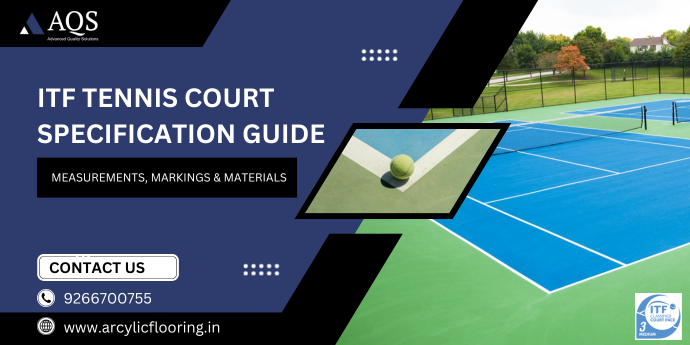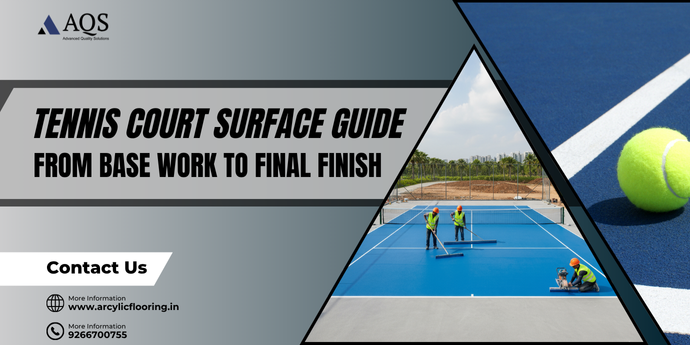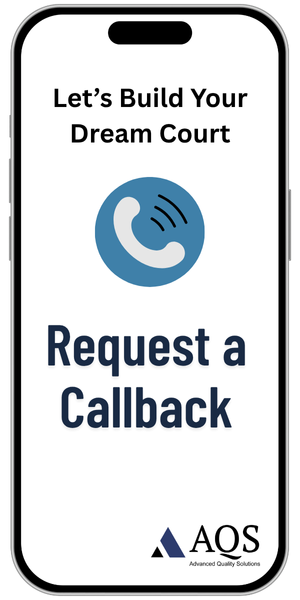Synthetic tennis courts are changing the way people play and enjoy tennis in Northern India. This is true in areas that face big weather changes. These newer courts, unlike older ones, offer reliable ball bounce and steady speed. Players of all skill levels now pick them more often than traditional courts. especially in areas that experience
Acrylic tennis court surfaces have become very popular because they last long and work well in all weather. This matters in India. Summers get very hot and long monsoons often disrupt tennis. These acrylic courts are easier to maintain than grass or clay courts. They also save a lot of water and reduce maintenance costs. Many schools, tennis academies and private clubs opt for these courts to provide places where people can play all year. Synthetic tennis court surfaces stand up to all kinds of weather without wearing out. In this post, we’ll look into why these courts are now the go-to option in Northern India and why players and owners find them so useful.
Why Synthetic Courts Are Becoming Popular in Northern India
Northern India is moving to synthetic tennis court flooring due to various connected reasons that make them a good option. These newer courts tackle regional issues and support the growing tennis community.
How weather patterns affect court surfaces
Northern India faces big weather changes that make it tough for regular court surfaces to last. The hot summers in Rajasthan and the heavy rains during the monsoon season put a lot of pressure on the quality and usability of courts. Synthetic courts work well in these conditions. They handle UV rays better and don’t crack or lose color even under strong sunlight.
Synthetic acrylic surfaces dry fast after rain. They often become usable in as little as 30 to 60 minutes so people can use them throughout the year even during monsoons. Their drying removes the issue of muddy and slippery conditions. This problem often makes clay courts unplayable for several days after it rains. Changes in temperature make court materials expand and shrink. But synthetic surfaces have enough flexibility to stop cracks which can harm performance. Northern India has seen a rise in tennis academies. TEAM Tennis has grown from one academy to a large network with over 200 coaches and 10,000 participants. This growth has created a need for stable playing surfaces so training is not affected by changing seasons.
India’s growing middle class is also a factor in this trend. Higher incomes give people more money to spend on hobbies like tennis. This shift in the economy has opened up tennis to more people and created demand for strong and low maintenance courts in cities. Tennis academies and city sports facilities growth
Northern India has seen a tennis academy boom. TEAM Tennis has grown from one academy to a large network with over 200 coaches and 10,000 participants. This growth has created a need to have stable playing surfaces so training isn’t affected by seasons.
India’s growing middle class is a reason for this trend. Higher incomes mean people have more money to spend on hobbies like tennis. This shift in the economy has opened up tennis as a sport and created demand for strong and easy to maintain courts in cities.
Government and private sector investments in sports facilities
Government initiatives have accelerated the construction of sports infrastructure. Khelo India launched in 2018 has provided funding for 282 sports infrastructure projects. These projects have received ₹12,066.40 crores over the last 5 years. ₹9,069 crores has been allocated by the National Infrastructure Pipeline to improve sports infrastructure.
India’s sports ecosystem now involves the private sector in building and running sports facilities. Public private partnerships have enabled private entities to play a big role. Models like Refurbish, Operate, Maintain and Transfer (ROMT) have made it easier to set up multi-purpose sports venues.
So, experts predict that Asia-Pacific region including India will see the fastest growth in synthetic tennis court market in the coming years. Northern India is a key player in this shift.
Main benefits of Synthetic Tennis Court Surfaces
Tennis players in Northern India know that synthetic acrylic courts perform better than traditional ones. These modern courts use special materials and smart designs to keep playing conditions ideal throughout the year.
Consistent ball bounce and speed
Synthetic tennis courts stand out because they offer consistent ball behavior. These surfaces ensure the ball bounces and moves at the same speed wherever it lands, unlike clay or grass courts. Players can plan their moves knowing how the ball will react to their shots. This stability makes competitive games more fair by focusing on players’ skills instead of surface quirks.
Easy maintenance and durability
Synthetic tennis courts can go up to 5-10 years without maintenance like resurfacing. Some courts last longer if taken care of. Natural grass courts require constant work like mowing, watering and fertilizing. Synthetic courts require cleaning occasionally and inspections to keep them in shape.Less maintenance means big savings in the long run. Facility owners love these courts because they handle a lot of foot traffic and avoid damage from UV rays. They keep their performance consistent as they age. Please provide the text you want me to paraphrase and I will rewrite it.
Year-round use in any season
One of the biggest advantages of synthetic tennis court installation is how well they handle the extreme weather in North India. They dry up fast after rain, usually in just a few minutes, so you can start playing again without worrying about slippery areas or standing water. Whether its the scorching heat of summer or the heavy rains of monsoon, these courts are in shape and ready to use. They are playable all year round so you can practice and train no matter the season.
Protection for players and their joints
Players’ long term health benefits from synthetic tennis courts which have shock absorbing features to reduce joint impact. The cushioned layer reduces stress on knees, ankles and lower back compared to harder court options. Synthetic surfaces also have texture which provides excellent traction. This traction reduces the chances of slipping but still allows you to slide in a controlled manner when needed. Balancing grip with movement on these courts can help prevent injuries during quick stops or changes of direction.
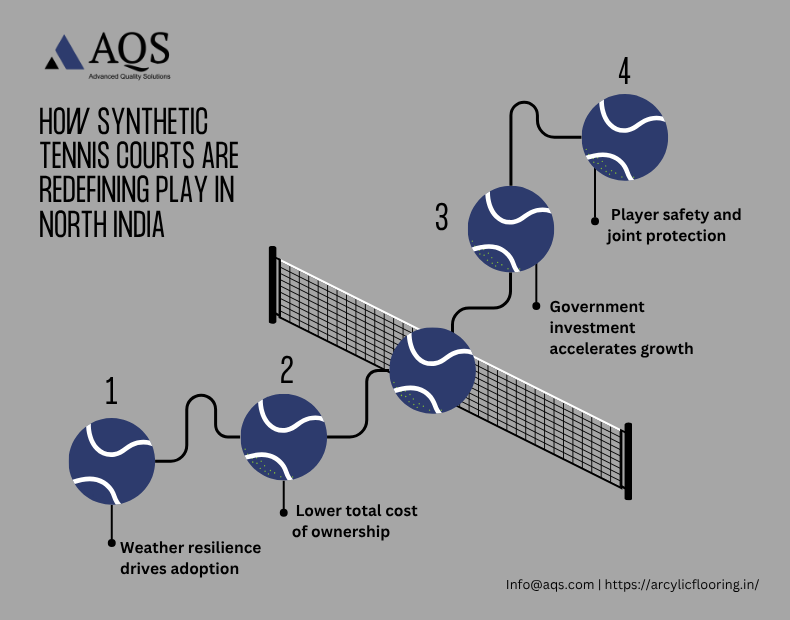
Synthetic vs Traditional Surfaces: Breaking It Down
To make smart choices about tennis courts, you need to understand how traditional and modern surfaces differ. Each type has its own unique qualities that affect how the game feels, the maintenance it needs and the cost attached to it.
Acrylic and synthetic tennis courts: how are they different?
Acrylic courts have a base of concrete or asphalt and are covered with layers of acrylic paint. Sand is added to adjust the pace of the court. Synthetic has a mix of materials like acrylic tennis court surfaces, synthetic clay and artificial grass. Acrylic courts are part of the synthetic group but synthetic surfaces as a whole provide better shock absorption and reduce joint strain compared to regular hard acrylic courts.
Synthetic or clay: maintenance and gameplay
Clay courts need daily maintenance. This means sweeping, watering and leveling every day and a big tennis court reconstruction effort every spring. Options like ClayTurf which is a synthetic clay offers the same kind of game (slow speed and high bounce). It takes around 30 minutes a week to keep it in shape. Synthetic clay also dries fast after rain so you can use it any time of the year. Natural clay becomes unplayable when it’s wet.
Synthetic clay and grass
Expenses and weather handling Grass courts are hard to maintain and need frequent mowing, watering and fertilizing which can be costly and time consuming. Synthetic surfaces handle different weather conditions well and stay intact for years – about 8 to 10 – and need basic maintenance. Even with higher setup costs, their lower maintenance over time makes them a much cheaper option.
Comparison of Environmental Impact of Each Court Surface
Synthetic courts use much less water than grass or clay courts. But some people worry if all synthetic materials are recyclable. Newer eco-friendly production techniques have fixed these issues as many modern synthetic courts now have materials that can be recycled reducing environmental harm during use and disposal.
Why Synthetic Courts are More Popular in North India Today?
Tennis courts in North India are shifting to synthetic courts to address the region’s specific challenges. This change is due to several major reasons that make synthetic surfaces better than traditional ones.
Durability in extreme heat and heavy rain
In North India’s harsh weather synthetic acrylic courts perform much better. They withstand heat and rain without cracking, warping or losing color. Unlike traditional courts they don’t trap moisture or get damaged by environmental changes. They also dry –often within 30 to 60 minutes after rainfall—so players can get back on the court faster even during the rainy season. This feature makes them playable throughout the year which is a big plus in areas with unpredictable weather.
Cost of synthetic tennis courts in India compared to others
The long term value of synthetic courts stands out when you look at ongoing tennis court flooring costs. Acrylic flooring costs square feet depending on layer systems. Clay courts may seem cheaper compared to synthetic courts. But over time low maintenance of synthetic surfaces proves to save more money.
Options to customize for schools, clubs and academies
Synthetic courts offer many options to customize which facility owners value. People can choose from different colors, textures, padding types and even add logos. Surfaces can range from basic to high end and can be customized as per requirements of schools, sports clubs or professional academies.
Synthetic tennis court materials and services available
In North India good quality materials and installation services are now easily available. Areas like Chandigarh, Mohali, Panchkula, Punjab, Haryana and nearby locations have access to these services. Skilled teams handle installations while keeping disruptions minimal.
Conclusion
Synthetic tennis courts have changed the face of tennis in Northern India, solving the age old problems of facility owners and players alike. They excel where traditional options fail, especially in extreme weather conditions that are so common in the region. Playability is the biggest advantage of synthetic courts. Uniform ball bounce and speed ensures fair play all year round and quick drying ensures the court is usable even during monsoon season. Reduced joint impact also protects player’s long term health, making these courts suitable for all ages and skill levels.
Financials favor synthetic options. Although initial cost is more than clay, minimal maintenance and 5-10 year life gives better value. This is especially beneficial for schools, clubs and academies working on a budget. Availability of installation services across Northern India has made quality synthetic courts available beyond metro cities. Customization options allow facility owners to design the surface as per their requirement, whether for recreational play or professional training. Synthetic tennis courts will only grow in Northern India as the climate becomes more unpredictable. Their durability, weather resistance and reduced resource consumption fits perfectly with modern sustainability agenda and meets the performance demands of today’s players. If you are planning new tennis facilities or upgrading existing ones, synthetic surfaces are worth a look.
Contact Now AQS, for tennis court flooring!
Frequently Asked Questions
Synthetic courts offer consistent ball bounce, quick drying after rain, durability in extreme weather, low maintenance requirements, and year-round playability. They withstand Northern India’s climate variations better than traditional surfaces.
Yes, synthetic courts incorporate shock-absorbing properties that reduce impact on joints compared to harder surfaces. They provide optimal traction to prevent slips while still allowing controlled sliding, helping to prevent injuries during quick movements.
Synthetic courts dry remarkably fast after rainfall, often within 30-60 minutes. This allows play to resume quickly even during wet seasons, maintaining year-round usability unlike clay courts that remain unusable in wet conditions.
Yes, synthetic courts offer extensive customization options. Facility owners can choose varied colors, textures, cushioning levels, and even integrate logos. Courts can be tailored to meet specific requirements of schools, clubs, or professional academies.

